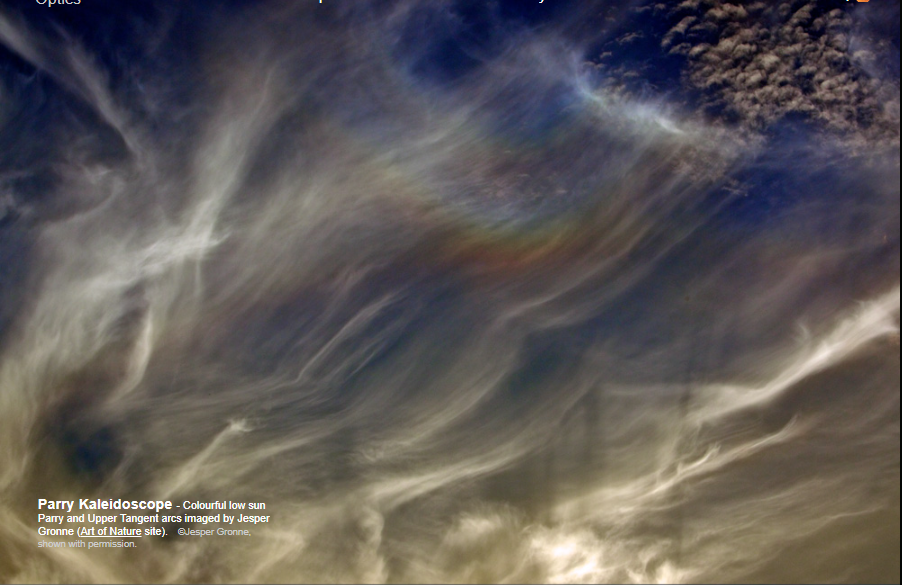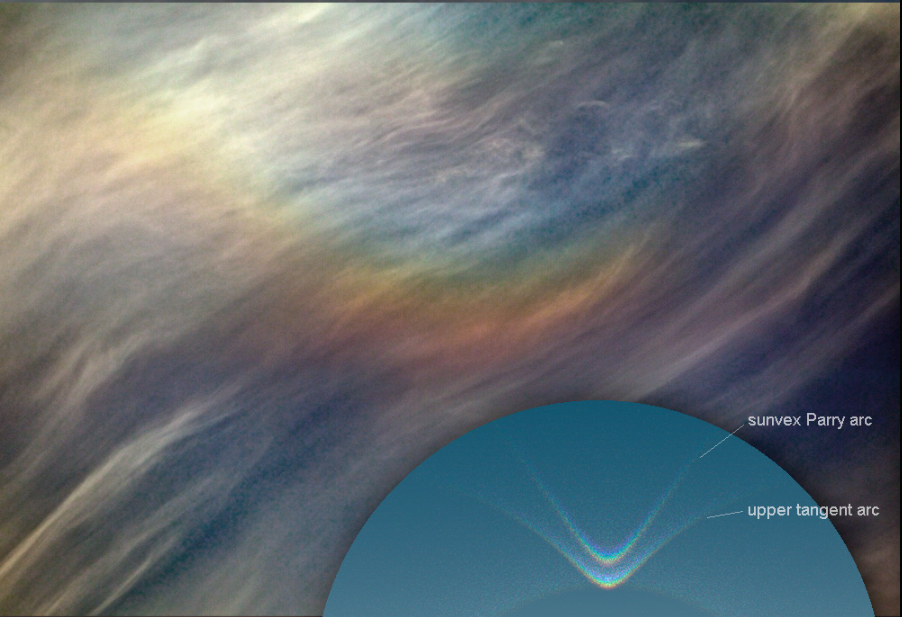Parry Kaleidoscope
Parry Kaleidoscope: A Stunning Atmospheric Phenomenon
When it comes to atmospheric optics, there are a multitude of mesmerizing phenomena that can occur. One such phenomenon is the Parry Kaleidoscope, which showcases vibrant and colorful low sun Parry and Upper Tangent arcs. These breathtaking displays of light have been captured by Jesper Gronne, a talented photographer known for his captivating images of nature.
The Parry Kaleidoscope consists of two distinct arcs: the upper arc, known as the sunvex Parry, and the lower arc, which is a more commonly observed upper tangent arc. When the sun is at a low angle in the sky, both arcs take on a distinctive 'V' shape and are positioned close together. As the sun approaches the horizon, these arcs merge into a single, awe-inspiring spectacle.
The formation of these arcs is attributed to the presence of horizontal column-shaped ice crystals within the atmosphere. However, it is the orientation of these crystals that differentiates the Parry arc from the upper tangent arc. Unlike other ice crystals that rotate freely about their long horizontal axis, Parry-oriented crystals remain fixed in position.
To fully appreciate the beauty of the Parry Kaleidoscope, it is important to understand the intricate mechanisms behind this phenomenon. As sunlight passes through these horizontally aligned ice crystals, it undergoes a process known as refraction. This refraction causes the light to bend and disperse into its component colors, resulting in a vivid display of hues.
The Parry arc, being a product of Parry-oriented crystals, is characterized by its distinct shape and position. Its 'V' shape is a result of the crystals' fixed orientation, which allows sunlight to refract at specific angles. On the other hand, the upper tangent arc is formed by ice crystals that freely rotate, resulting in a more common arched appearance.
While witnessing a Parry Kaleidoscope is undoubtedly a breathtaking experience, it is important to note that these atmospheric phenomena are relatively rare. They occur most frequently in polar regions where the atmospheric conditions are conducive to the formation of ice crystals with the required orientation.
In addition to the Parry and Upper Tangent arcs, other optical phenomena can also accompany the Parry Kaleidoscope. These may include the familiar 22° halo, sundogs, and even circumzenithal arcs. Each of these phenomena adds to the overall spectacle, creating a visual feast for those fortunate enough to witness it.
To capture the full beauty of the Parry Kaleidoscope, photographers like Jesper Gronne employ their skills and patience. Through careful observation and precise timing, they are able to immortalize these ephemeral moments of atmospheric magic. Their photographs not only serve as stunning visual records but also contribute to our understanding of these complex optical phenomena.
In conclusion, the Parry Kaleidoscope is a captivating atmospheric phenomenon that showcases the vibrant interplay of light and ice crystals. With its distinctive 'V' shaped Parry arc and adjacent upper tangent arc, this spectacle is a testament to the wonders of nature. While rare, witnessing a Parry Kaleidoscope is an experience that will leave observers in awe of the beauty and complexity of our atmosphere.

Parry Kaleidoscope - Colourful low sun Parry and Upper Tangent arcs imaged by Jesper Gronne (Art of Nature site). ©Jesper Gronne, shown with permission.


The upper arc is the sunvex Parry. The lower is a more common upper tangent arc. At low sun both are 'V' shaped and close together. They merge when the sun is on the horizon.
Both are produced by horizontal column shaped ice crystals. The difference arises because Parry oriented crystals do not rotate about the long horizontal axis.
Note: this article has been automatically converted from the old site and may not appear as intended. You can find the original article here.
Reference Atmospheric Optics
If you use any of the definitions, information, or data presented on Atmospheric Optics, please copy the link or reference below to properly credit us as the reference source. Thank you!
-
<a href="https://atoptics.co.uk/blog/parry-kaleidoscope/">Parry Kaleidoscope</a>
-
"Parry Kaleidoscope". Atmospheric Optics. Accessed on November 21, 2024. https://atoptics.co.uk/blog/parry-kaleidoscope/.
-
"Parry Kaleidoscope". Atmospheric Optics, https://atoptics.co.uk/blog/parry-kaleidoscope/. Accessed 21 November, 2024
-
Parry Kaleidoscope. Atmospheric Optics. Retrieved from https://atoptics.co.uk/blog/parry-kaleidoscope/.